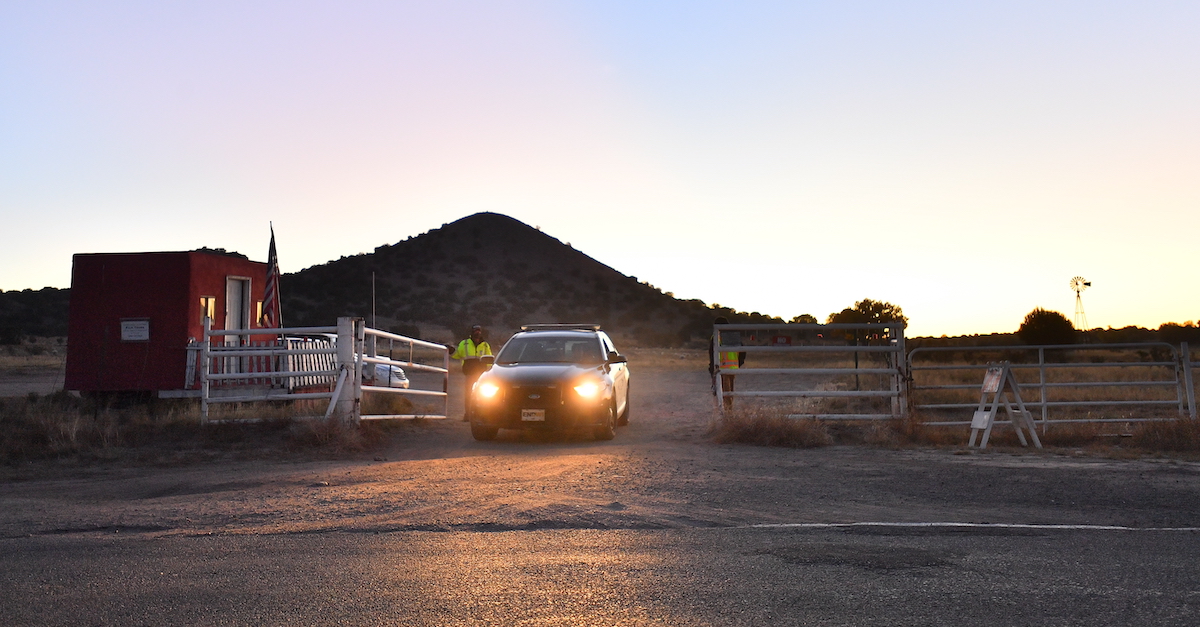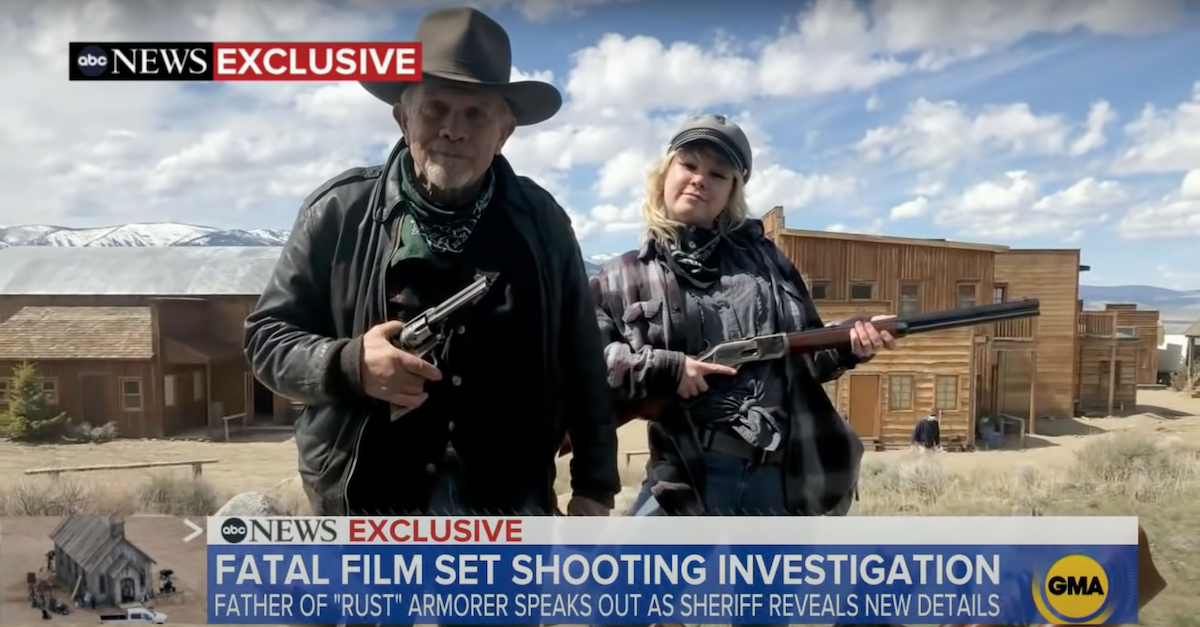
Alec Baldwin attended the 2021 RFK Ripple Of Hope Gala at New York Hilton Midtown on December 9, 2021 in New York City. (Photo by Dimitrios Kambouris/Getty Images.)
Alec Baldwin on Tuesday suggested he was “fanning” a revolver on the set of the Western film Rust when the movie’s cinematographer was fatally shot.
Baldwin made the comments to podcast host and ex-CNN anchor Chris Cuomo as a cache of FBI documents and other law enforcement materials were released about the deadly shooting. Prosecutors in New Mexico, where the incident occurred, are still reviewing the material and waiting for additional documents pertaining to Baldwin’s phone to ascertain whether or not to file a criminal case against anyone in connection with the fatality.
The Podcast Interview
Cuomo said Baldwin’s explanation of what happened “didn’t come out really in that ABC News interview” last year.
“You said you never pulled the trigger, but the gun went off,” Cuomo asked.
“Right,” Baldwin said.
“You do the ABC interview, and it was kind of left there,” Cuomo pondered. “That will not make sense to people.”
After some crosstalk, Baldwin started discussing the process of “fanning” a gun. Baldwin didn’t directly state — but he did suggest — that he was engaged in that process when the fatal wound occurred.
“If you pull the hammer back, and you don’t lock the hammer — if you pull the hammer back pretty far — in old Western movies you’d see someone ‘fan’ the hammer of the gun. The hammer didn’t lock. You pulled it back to an extent where it would fire the bullet without you pulling the trigger, without you locking the hammer.”
Baldwin then shifted the topic toward assertions that the gun was both “cold” and “safe.”

A Santa Fe County Sheriff’s Office car leaves through the entrance to the Bonanza Creek Ranch on October 22, 2021 in Santa Fe, New Mexico. (Photo by Sam Wasson/Getty Images.)
“The man who was the principal safety officer on the set of the film declared that the gun was safe when he handed it to me,” Baldwin said. “The person who was the principal safety officer of the film declared in front of the entire assemblage, ‘this is a cold gun.’ Now, why did he say that if he didn’t know — if he hadn’t checked. The point is all of us were told that everything was cool.”
But Baldwin also said he had been warned that a bullet could be expelled from the chamber if, indeed, a live round was in the gun and the hammer was allowed to lurch forward.
“He explained it to me effectively: that [that’s] exactly what can happen if you pull a hammer back and let it go and there’s a live round,” Baldwin continued. “So, there’s only one question to ask here: who put a live round in the gun? That’s it. There is no other question to ask.”

The set of the movie “Rust” at Bonanza Creek Ranch appears in an Oct. 22, 2021 photo. A fatal shooting occurred on the set the day before at the hands of Alec Baldwin. (Photo by Sam Wasson/Getty Images.)
Cuomo asked Baldwin if he believed he had been set up. The actor said he initially believed what happened was an accident; he said he worked with “private investigators” and examined “information we accessed” to bolster his belief that the shooting was “likely” was an accident.
Baldwin suggested that one person or two people responsible for safety on the film set were “negligent.”
The actor then delivered a tangent about the Kennedy assassination and suggested that Lee Harvey Oswald could not have “pumped off” three shots at the then-president in 1963. Baldwin used the conspiracy theory-laden peripheral to elucidate that while he can be taken to believe such missives, he does not believe a conspiracy was afoot against him on the New Mexico set of Rust. He said he considered but then refuted such a scenario involving Rust.
When discussing myriad civil lawsuits surrounding the shooting, Baldwin distinguished “managerial” producers and “creative” producers and suggested, but did not outright state, that he was in the lesser category of potential culpability — but, either way, he said insurance policies indemnified those named.
Baldwin said he did not believe the set was “unsafe.”

A KOAT-TV screengrab shows police activity at the Bonanza Creek Ranch near Santa Fe, N.M., after a deadly shooting on the set of the film “Rust” on Oct. 21, 2021.
“Confusion was what reigned that day,” Baldwin explained, “because what happened . . . wasn’t even in the realm of possibility” based on the beliefs of those present and their collective trust in the film’s safety procedures.
“I’m not the victim here,” Baldwin reminded Cuomo’s audience. “Things for me are going to get better. Things for me are going to get cleared up.”
“Why would anybody believe that I worked in this business for 40 years and that day I decided to play with a gun? That’s the dumbest thing I’ve ever heard,” the actor continued. “All behavior is consistent. I’ve worked in this business for years and with cars, stunts, weaponry — if there was a title of a chapter of a book, it would be called ‘without incident.’ I never had one problem in all my years of making movies, and especially when I was younger running down the tarmac with a gun in my hand, or in a car.”
Baldwin said he wanted the public understand what is “true” about the on-set fatality.
The actor turned his attention several times toward lamenting the loss of Halyna Hutchins and noted that she had a young son who now does not have a mother.
Cuomo suggested that he doesn’t believe Baldwin will face charges — for what his opinion is worth.

Halyna Hutchins appears in a photo released by her family’s attorneys.
FBI Reports
Several of the law enforcement documents prepared by the FBI were obtained Tuesday by Law&Crime after terse and conclusory sections from the materials were published by ABC News late Friday.
The tests performed on the gun Baldwin used in the since-scuttled film indicate as follows:
Accidental Discharge Testing
Hammer at rest (de-cocked on a loaded chamber)
With the hammer at rest on a loaded chamber, Item 2 detonated a primer without a pull of the trigger when the hammer was struck directly. With a revolver of this design, when the hammer is at rest on a loaded chamber, the firing pin sits directly on the primer of the cartridge. When force is applied to the hammer, such as striking or dropping, it can fire the cartridge without a pull of the trigger. This is consistent with normal operation for a single-action revolver of this design.
Hammer at 1⁄4 and 1⁄2 cock positions
With the hammer in the 1⁄4 and 1⁄2 cock positions, Item 2 could not be made to fire without a pull of the trigger. When enough pressure was applied to the trigger, each of these safety positions were overcome and the hammer fell. This is consistent with normal operation for a single-action revolver of this design.
With the hammer in the 1⁄4 cock position, pressure was applied to the trigger and the hammer fell, however the firing pin did not have enough force to detonate the primer and resulted in light firing pin strikes.
With the hammer in the 1⁄2 cock position, pressure was applied to the trigger and the hammer fell, however the cylinder could not be properly aligned to the bore, the firing pin struck the outer headstamp area and did not detonate the primer.
Hammer at full cock position
With the hammer in the full cock position, Item 2 could not be made to fire without a pull of the trigger while the working internal components were intact and functional. During this testing, portions of the trigger sear and cylinder stop fractured while the hammer was struck. The fracture of these internal components allowed the hammer to fall and the firing pin and detonated the primer. This was the only successful discharge during this testing and it was attributed to the fracture of internal components, not the failure of the firearm or safety mechanisms.
Those tests, however, came with significant caveats, as the report explains:
Accidental Discharge
An accidental discharge test is conducted in all modes of fire for a particular firearm, utilizing a primed cartridge case or shotshell case. The firearm is struck with a rawhide or similar styled mallet on its six planes: front of muzzle, butt plate, top of breech and chamber, bottom of trigger guard and frame and both sides of the receiver/frame. If necessary, tests can be undertaken in order to attempt to duplicate the conditions under which the firearm discharged.
“When an accidental discharge examination is performed, it may not be possible to recreate or duplicate all of the circumstances which led to the discharge of a firearm without a pull of the trigger,” the reports also indicate.
It is unclear whether any any test involving “fanning,” the technique described by Baldwin, was requested; however, the reports suggest such a technique was not directly performed.
The FBI reports also say nothing of the weight necessary to “pull” the trigger. So-called “light” guns — with hair triggers — require as little as two pounds or fewer for a successful trigger pull; “heavy” guns require approximately eight pounds of force. Guns used for self-defense purposes tend to be heavier because the purpose of discharging the weapon is a deliberate act of protection; sport shooters sometimes prefer lighter guns because they can be more accurate. The latter, however, carry a greater capacity for accidental discharge.

Halyna Hutchins and her family appear in a photo released by her family’s attorneys.
Medical Examiner’s Findings
The manner of Hutchins’ death was listed as an “accident” by a medical investigator in New Mexico.
The gunshot wound “entered the right chest cavity and perforated the right lung, exited the right chest, injured the thoracic spinal column and the thoracic spinal cord, and exited the left aspect of the back.”
“The absence of visible soot on the clothing and the entrance wound is most consistent with a distant range of fire,” the medical examiner’s report indicated. “The direction of wounding is front to back, right to left, and downward.”
A separate toxicology report on Hutchins’ body revealed nothing of “toxicological significance.”
The report tidied up the myriad tests and findings into this narrative conclusion:
Review of case supplemental reports provided by law enforcement demonstrated that a firearm (a .45 Long Colt single-action revolver) was loaded by the armorer, handed to the assistant director, and then subsequently handed to the actor on set. According to reports, the firearm was believed to be loaded with dummy rounds for the rehearsal. The actor reportedly raised the firearm toward the camera as part of the rehearsal, which subsequently discharged and struck Ms. Hutchins, as well as the director, who was reportedly standing behind Ms. Hutchins. The projectile was later recovered from the director at a hospital.
A firearms/toolmarks examination was performed by the FBI Laboratory, which was issued on 7/26/2022, that demonstrated that the .45 revolver functioned normally when tested. Additionally, the projectile recovered from the director (Mr. Joel Souza) was a .44/.45 caliber lead bullet that could not be compared to the firearm secondary to damage. Thirdly, examination of a .45 Colt cartridge case demonstrated that it had been fired in the revolver examined.
Death was caused by a gunshot wound of the chest. Review of available law enforcement reports showed no compelling demonstration that the firearm was intentionally loaded with live ammunition on set. Based on all available information, including the absence of obvious intent to cause harm or death, the manner of death is best classified as accident.
Attorneys Disagree
The release of the reports has led to disagreement among attorneys over exactly what occurred.
Baldwin attorney Luke Nikas told NPR and ABC News that the FBI findings have been “misconstrued” and that the gun was not well maintained.
“The gun fired in testing only one time — without having to pull the trigger — when the hammer was pulled back and the gun broke in two different places,” Nikas said in a statement. “The FBI was unable to fire the gun in any prior test, even when pulling the trigger, because it was in such poor condition.”

Famous armorer Thell Reed, who was not involved with “Rust,” and his daughter Hannah Gutierrez Reed, who was, appear in an ABC News screengrab.
Jason Bowles, an attorney for Rust armorer Hannah Gutierrez Reed, told NPR that Baldwin “ignored” his client’s requests for cross-draw training — which he said would have included a warning to not touch the trigger of the weapon in the process.
Bowles also contested the Nikas’ claim that the weapon wasn’t well maintained.
“The newly released FBI reports show the revolver was in good working order and that Baldwin had to have pulled the trigger to fire the revolver, directly contradicting his prior statements,” Bowles reportedly said.
“Hannah was tasked with doing two jobs including props assistant and the very important job as armorer but not given adequate time and training days to do so despite repeated requests or the respect required of the armorer’s position and responsibilities,” Bowles reportedly added.
Copies of the most of the reports obtained by Law&Crime are embedded below. We’ve omitted the more graphic sections of the autopsy report: